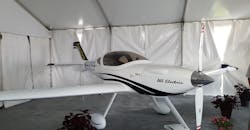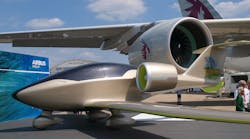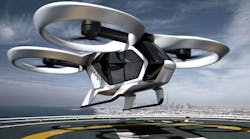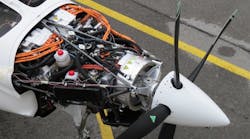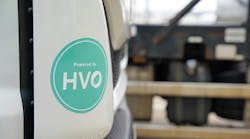If you are trying to follow today's technological aviation news these words are popping up in almost an annoying manner: E-Flight and the Green Flight. As soon as you think you understand the meaning of those words, a new version of the meaning or its synonym is there. So what does E-Flight mean and why is it used together with the word Green? Is this going to affect our future? Is this trend likely to affect us now, in a few years, or is it only a possible, long-term perspective? Questions and possible answers are: yes, no, maybe, for sure and never.
Our initial intention was to write one article and explain the world of electric flight. It soon became obvious that much more space was needed for this, let's call it aircraft electrification.
This is just a teaser article and it's going to give you a superficial overview of the "Electric Aviation World." More articles will follow in next issues of AMT; each of those articles will focus on a different aspect in more detail. We will talk about electric propulsion/flight, electric subsystems, about different types and families of aircraft which are and will be partially or solely electrically propelled, about the storage and production of electric energy on board of airplanes, and finally about the impact of electricity on aviation and on a possibly greener future in aviation.
A simple explanation of electric flight is not there because too many meanings are hidden and are used around this term. Actually, it will be easier and more correct to talk about the use of electric energy in aviation because the use of electricity is what is behind the meaning and E-Flight.
Electric Flight
Electric propulsion is already in our lives, there are tons of electric bicycles, scooters in the streets, and cars that are not head turners any more - electricity provides that extra impulse to get modern travelers on their way.
We have already seen many, more or less successful, propulsion applications in the automotive world ranging from various hybrids to pure electric solutions. The energy for propulsion and electricity needed for the electronic components that allow you to drive and control those electric motors in cars could be applied to aviation.
E-Flight Roots
So, if this is nothing special anymore on the road, why don’t we see any electric aircraft? Well this is not true because the Slovenian UL/LSA manufacturer Pipistrel exhibited and offered for sale the all-electric two-seat Alpha Trainer at AirVenture 2017. Even the FAA personnel who were spotted in the booth were surprised that this aircraft is in serial production and legal to fly in some countries.
Visitors to AERO 2017 in Germany could witness a real fireworks of novelties. This electric trend in Europe has once more picked up speed. Companies such as Siemens AG, Pipistrel, Geiger, MGM Compro, Evolaris, Engiro, just to mention a few, and some universities presented various electrically powered aircraft and (near) serial ripeness hybrid propulsion systems. The overall trend goes toward less noisy and more ecological drivetrain solutions and these were even seen at the last Paris Airshow.
This process is in reality a process which was initiated some 10 years ago and has its roots in the "small," experimental aviation world. Few visionary entrepreneurs and aviators on both sides of the Atlantic Ocean broke ground for today’s electric revolution. That this development originates in the experimental/LSA yard is based on less restrictive rules in those categories and on the fact that many visionaries in that world had excellent ideas, were driven by emotions and were not really the best accounting specialists.
This trend has gained momentum in the last few years, especially in Europe where environmental awareness and noise restrictions together with much higher fuel prices fostered development. A special boost to this electric powered flight came from China where ideas translate much faster to production.
Some two years ago, Airbus reached a milestone when its two-seater, battery-powered E-Fan crossed the British channel in just 40 minutes in a purely electric-powered aircraft trainer. A few days earlier French amateurs with the electric Cri-Cri, an amateur built -micro- aircraft, did the same thing. The Slovenian UL/LSA manufacturer Pipistrel crossed the channel days later in an all-electric two-seat Alpha Trainer.
The World of "Conventional" E-Aircraft
There are many examples of new and converted or adapted airframes which have become valid all electric aircraft. Besides the Pipistrel and Alpha Trainer there are many manufacturers and entrepreneurs which are pursuing this all-electric way in conventional fixed-wing aircraft.
As an example we have to mention the conventionally looking Aero Electric Aircraft Corp. (AEAC) and its two-seat Sun Flyer trainer together with the bigger brother called Sun Flyer 4 airplane. The Sun Flyer 4 will have a payload of 800 pounds for pilot and passengers, and should stay airborne for four hours with a $19-per-hour operating cost.
An Unconventional Fixed-wing Aircraft
An all new project is the XTI Aircraft. It is an all new design, conventionally looking, fixed-wing aircraft with unconventional propulsion. The American Company and its CEO Robert LaBelle presented the TriFan project at the 2017 Paris Airshow. The six-seat airplane will possibly have the speed, range, and comfort of a business jet and the ability to take off and land vertically. The three swiveling fans driven by twin Siemens electric motors will be powered by a not-yet-disclosed and dislocated turbine/generator unit.
Distributed Propulsion: the Game Changer
Electric propulsion opens new possibilities which conventional engine-propeller combinations are not able to deliver. The base of the advantage is the so-called distributed propulsion. It means that the energy source (the battery pack, combustion engine, generator, and similar) could be located even far away from the electric motor(s). This initially not-so-important looking fact is possibly a real game changer because it opens new not yet available options allowing the separation of the energy source from the electric motor/propeller. In this way the generator and batteries (the energy source) which are usually heavy could be located close to the aircraft center of gravity and inside the fuselage and the electric motors could be located where the designer needs them and where they may give the biggest benefit/efficiency. This allows two now not available options: an almost unlimited number of motors/propellers, and their location. They can be positioned almost anywhere on the aircraft: the wings, tail, and fuselage.
This large number of propellers may translate in a huge saving of energy needed for the flight says NASA. Its project called X-57 Maxwell is a good example. Fourteen electric motors will turn propellers located on a uniquely designed wing; 12 on the leading edge for take off and landing and one larger motor on each wing tip for use during cruise altitude.
Another new concept based on distributed power is the German Lilium airplane. No other company is promising the economy, speed, range, and low noise levels of the Lilium Jet. A remotely flown two-seat prototype flew in April showing that it could take off vertically and then smoothly transition to horizontal flight.
Electric Multicopters
The electric revolution has started with toys and small drones. Powered by a multitude of electric motors that over time have grown to the size of a small to medium helicopter giving birth to a new breed of rotary wing aircraft. This is the birth of the dream of autonomous personal point-to-point transportation.
The American Electric-drive truck manufacturer Workhorse showcased a hybrid-electric vertical-takeoff-and-landing (eVTOL) aircraft called SureFly this year. The octocopter, which design is reminiscent of the Chinese Ehang 184 drone, builds on Workhorse’s development of the HorseFly delivery drone, has four arms with two electric motors on their end. It is powered by a nondisclosed 200-hp turbocharged combustion engine which drives a generator backed up by a dual-battery system.
The German Volocopter 2X was recently launched into the market. This vertical take-off and landing aircraft is purely powered by electric energy and capable of carrying two persons. Its 18 electric motors give high failure tolerance and the ability to fly emission-free, and with low-noise.
The above listed examples show what is already doable today and what is needed for an electric flight. For satisfactory results the following factors are needed: An airframe, families of reliable electric motors, matched by proprietary energy (electric) controllers, and last but not least suitable batteries and/or alternative energy sources.
There are enough aerodynamically efficient airframes around especially in the experimental-friendly world of Ultra-Light or LSA airplanes. Last year Siemens developed several electric motors for LSA/GA aviation use and electric management systems/controllers are already available and are daily refined, so the only problematic component is the electric energy source and its storage.
Where's the Electric Airliner?
A hybrid airliner, which will combine the advantages of electric motors with the range extending capabilities of conventional piston and turboprop engines, might be a solution. However, scaling up the current technology to a development of a family of airliners in the 10- to 19-seat range for the early 2020s is going to be a big challenge. An even bigger challenge will be the creation of 50- to 100-seat aircraft for the airline market. Here the solution might be the use of conventional jet turbine technology and even stronger (not yet developed) electric motors.
Airbus and Boeing have already started to dream the electric airliner dream with several projects.
Zunum Aero, a Kirkland, WA-based startup, developed a hybrid aircraft, with financial backing from Horizon X, Boeing's innovation cell, which focuses on accelerating potentially transformative aerospace technologies. Another project is the JetBlue Technology Ventures, a California-based incubator of early stage technology and travel startups.
Boeing is since September offering $2 million in prize money to encourage innovators to create a “safe and easy-to-use personal flying device.” The two-year competition, called “GoFly” is open to around the world competitors. Boeing hopes the project will give a push to aircraft propulsion, energy, lightweight materials, and control and stability systems and will “make the dream of personal flight a reality.”
Airbus dreams are called Vahana and CityAirbus. Airbus is studying different options. One area is small, short-range VTOL urban air mobility demonstrator projects. These would be fully electric aircraft for between one and four passengers. The other area, in the longer term, would be a large commercial aircraft.
Range Extender & Hybrids
At this time batteries don’t assure enough range for passenger transportation purposes and an alternative has to be found. The solution is already known from the automotive world, tested in the Pipistrel Hypstair project, and is called hybrid technology. Hybrid architecture, paired with a range extender, seems as now to be one solution.
Range extender technology is right now the only viable way to get to a bigger electric-propelled aircraft. Current commuters could easily be adapted for this technology. Here we could say a 10-seat aircraft whose electric-driven props will be powered by combustion engine generators, or possibly small/medium turboprops. This is a viable way as the aircraft could be charged/fueled by the existing infrastructure, with minimal new infrastructure at airports.
During the GE Aviation press briefing at NBAA BACE this year, the company said it has configured the GE F110 jet-engine, used in the F-16 to generate a million watts of electric energy so an electric airliner might not be just a dream.
Electric Taxiing
This opportunity to save fuel and minimize the noise molestation on airports is another benefit of the use of electric energy in aircraft. Recently, Safran Landing Systems has met with airlines to present its electric taxiing system, since carriers today are very attracted by this type of taxiing solution which is more efficient and sustainable. Safran’s electric taxiing system would give airlines a solution that combines savings on operating costs and taxi without requiring tugs nor the aircraft engines.
Electric-Powered Aircraft Systems
This field will further develop because most aviation manufacturers are investing considerable money on modification of existing, and design of new, electrically driven systems and components. It is easier to control and manage mechanical systems electrically than with direct or hydraulically powered systems. The reason for such development lays in the fact that it is easier to control and manage mechanical systems electrically than in existing ways (i.e. hydraulically). The best example is the Boeing 787 - the most "electrical" airliner. The Dreamliner generates and uses way more electricity, than older designs, to power airplane systems such as hydraulics, engine start, braking, and wing ice protection.
Recently I was able to see that Liebherr-Aerospace developed and is testing, among others, new electrically powered air management systems which don't need the precious turbine bleed-air and can pretty easily be retrofitted to existing airlines.
Energy Storage
Batteries are used in a limited amount in today’s airplanes but their importance, the quantity and quality, is going to change in a radical and dramatic way in years to come. The batteries will be included in the aircraft of the future not only as a subsystem or actuator but will probably become their essential part possibly even as the primary energy source.
For larger aircraft, Airbus see hybrid propulsion before going fully electric as the power-to-weight ratios for battery technology are still a long way short of what is required. Current batteries are far too heavy to fly a large passenger aircraft. Having this in mind, battery research has the need of the biggest possible investment of any technology available in the world right now.
Ecological Benefits
Aviation's environmental challenge is nothing new. In the past, the industry has been dismissive and defensive but the new technology and innovation are finally apparently delivering green shoots of sustainability. Some manufacturers dream of 80 percent lower carbon emissions for the first versions of the electric airplanes vs. conventional ones; this could possibly rise to 100 percent over time if battery densities improve.
In all these discussions and predictions we have to consider something else, and this might not be so positive for us. Electrical energy is to be considered clean only if it is produced with renewable energy sources. Many of us have forgotten that this "green leaf" that electrical energy is wearing is not as green as we might imagine especially if it is being produced in powerplants where coal and oil are being burned.
